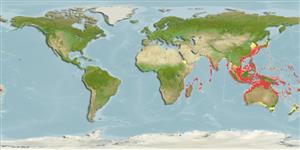Common names from other countries
分类 / Names
俗名 | 同种异名 | Catalog of Fishes(属, 种) | ITIS | CoL | WoRMS | Cloffa
Teleostei >
Eupercaria/misc (Various families in series Eupercaria) >
Priacanthidae (Bigeyes or catalufas)
Etymology: Pristigenys: Greek, pristis = saw + Greek, genys, -yos = face (Ref. 45335).
More on author: Cuvier.
Environment: milieu / climate zone / 深度上下限 / distribution range
生态学
海洋 礁区鱼类; 深度上下限 1 - 250 m (Ref. 100719), usually 5 - 30 m (Ref. 94109). 熱帶
Western Pacific: Japan, East China Sea Shelf, Taiwan, South China Sea, Vietnam, Celebes, Australia, and Indonesia.
印度-西太平洋: 紅海到南非; 日本南部到阿拉弗拉海 (參考文獻 9819) ,澳洲西部與昆士蘭省。 在印度的發生是可疑的。
大小 / 重量 / 年龄
成熟度: Lm ? range ? - ? cm
Max length : 27.4 cm SL 雄鱼/尚未辨别雌雄; (Ref. 5403)
背棘 (总数) : 10; 背的软条 (总数) : 11; 臀棘: 3; 臀鳍软条: 10; 脊椎骨: 23. This species is distinguished from its congeners by the following set of characters: D X,11; A III,10; total gill rakers on first arch 27-31, mode 27 (upper limb 7-10, lower 19-22); lateral-line scales 31-39, mode 35; body scales above pectoral fin with about 11-60 spinules on posterior margin, the number increasing with growth; generally rounded caudal fin in young, becoming somewhat double emarginate in adults (noticeable in specimens over 15.0 cm SL); absence of black margins on posterior soft portions of vertical fins; 5 white or pale vertical bands (often indistinct) on body about 1/2-3/5 width of pupil expanded ventrally and dorsally with latter angled posterodorsally, very notable in young, less obvious in adults (Ref. 94109).
Body shape (shape guide): short and / or deep; Cross section: compressed.
身体明亮的鲜红色的有 3-4个狭窄的灰白纵带; 中央的鳍有狭窄的黑色边缘; 腹鳍暗红色, 黑色的末梢部地.(参考文献 4328)
Associated with rocky habitats and known from 80 to more than 100 m depth but probably also occurring in shallower water, especially as juveniles (Ref.5403). From dive observations, juveniles and young individuals likely occur at 5-30 m depths (Ref. 94109). Eggs are pelagic (0.75 mm), small and spherical.
伴随着岩石的栖息地了而且已知来自 80 到超过 100 公尺深但是可能也出现在较浅的水域中, 尤其当稚鱼时。 卵是大洋性的 (0.75 mm) ,小的与圆球状的。
Life cycle and mating behavior
成熟度 | 繁殖 | 产卵场 | 卵 | 孕卵数 | 仔鱼
印度-西太平洋: 紅海到南非; 日本南部到阿拉弗拉海 (參考文獻 9819) ,澳洲西部與昆士蘭省。 在印度的發生是可疑的。
Iwatsuki, Y., T. Matsuda, W.C. Starnes, T. Nakabo and T. Yoshino, 2012. A valid priacanthid species, Pristigenys refulgens (Valenciennes 1862), and a redescription of P. niphonia (Cuvier in Cuvier & Valenciennes 1829) in the Indo-West Pacific (Perciformes: Priacanthidae). Zootaxa 3206:41-57. (Ref. 94109)
世界自然保护联盟红皮书 (Ref. 130435: Version 2025-1)
人类利用
渔业: 商业性
工具
特别资料
下载 XML
网络资源
Estimates based on models
Preferred temperature (参考文献
123201): 20.8 - 28.9, mean 27.6 °C (based on 972 cells).
Phylogenetic diversity index (参考文献
82804): PD
50 = 0.5312 [Uniqueness, from 0.5 = low to 2.0 = high].
Bayesian length-weight: a=0.02239 (0.00954 - 0.05253), b=2.93 (2.72 - 3.14), in cm total length, based on LWR estimates for this (Sub)family-body shape (Ref.
93245).
营养阶层 (参考文献
69278): 3.9 ±0.5 se; based on size and trophs of closest relatives
回复力 (参考文献
120179): 高度, 族群倍增时间少于 15个月 (Preliminary K or Fecundity.).
Fishing Vulnerability (Ref.
59153): Low vulnerability (23 of 100).
🛈
Nutrients (Ref.
124155): Calcium = 59 [29, 100] mg/100g; Iron = 0.642 [0.372, 1.050] mg/100g; Protein = 18.8 [17.6, 20.0] %; Omega3 = 0.143 [0.085, 0.240] g/100g; Selenium = 47.3 [25.9, 86.6] μg/100g; VitaminA = 48.2 [13.8, 166.8] μg/100g; Zinc = 0.988 [0.669, 1.420] mg/100g (wet weight);
